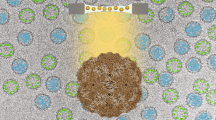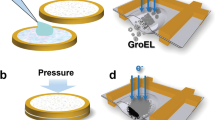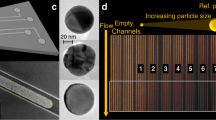Abstract
Most enzyme studies are carried out in bulk aqueous solution, at the so-called ensemble level, but more recently studies have appeared in which enzyme activity is measured at the level of a single molecule, revealing previously unseen properties1,2,3,4. To this end, enzymes have been chemically or physically anchored to a surface, which is often disadvantageous because it may lead to denaturation. In a natural environment, enzymes are present in a confined reaction space, which inspired us to develop a generic method to carry out single-enzyme experiments in the restricted spatial environment of a virus capsid. We report here the incorporation of individual horseradish peroxidase enzymes in the inner cavity of a virus, and describe single-molecule studies on their enzymatic behaviour. These show that the virus capsid is permeable for substrate and product and that this permeability can be altered by changing pH.
This is a preview of subscription content, access via your institution
Access options
Subscribe to this journal
Receive 12 print issues and online access
$259.00 per year
only $21.58 per issue
Buy this article
- Purchase on Springer Link
- Instant access to full article PDF
Prices may be subject to local taxes which are calculated during checkout




Similar content being viewed by others
References
Lu, H. P., Xun, L. & Xie, S. Single-molecule enzymatic dynamics. Science 282, 1877–1882 (1998).
Min, W. et al. Fluctuating enzymes: lessons from single-molecule studies. Acc. Chem. Res. 38, 923–931 (2005).
Engelkamp, H. et al. Do enzymes sleep and work? Chem. Commun. 935–940 (2006).
Flomenbom, O. et al. Stretched exponential decay and correlations in the catalytic activity of fluctuating single lipase molecules. Proc. Natl Acad. Sci. USA 102, 2368–2372 (2005).
Vriezema, D. M. et al. Self-assembled nanoreactors. Chem. Rev. 105, 1445–1489 (2005).
Douglas, T. et al. Synthesis and structure of an iron(III) sulfide–ferritin bioinorganic nanocomposite. Science 269, 54–57 (1995).
Meldrum, F. C., Heywood, B. R. & Mann, S. Magnetoferritin—in vitro synthesis of a novel magnetic protein. Science 257, 522–523 (1992).
Ueno, T. et al. Size-selective olefin hydrogenation by a Pd nanocluster provided in an apo-ferritin cage. Angew. Chem. Int. Edn 43, 2527–2530 (2004).
Seebeck, F. P., Woycechowsky, K. J., Zhuang, W., Rabe, J. P. & Hilvert, D. A simple tagging system for protein encapsulation. J. Am. Chem. Soc. 128, 4516–4517 (2006).
Varpness, Z., Peters, J. W., Young, M. & Douglas, T. Biomimetic synthesis of an H2 catalyst using a protein cage architecture. Nano Lett. 5, 2306–2309 (2005).
Douglas, T. & Young, M. Host–guest encapsulation of materials by assembled virus protein cages. Nature 393, 152–155 (1998).
Douglas, T. et al. Protein engineering of a viral cage for constrained nanomaterials synthesis. Adv. Mater. 14, 415–418 (2002).
Douglas, T. & Young, M. Viruses: Making friends with old foes. Science 312, 873–875 (2006).
Flynn, C. E., Lee, S.-W., Peelle, B. R. & Belcher, A. M. Viruses as vehicles for growth, organization and assembly of materials. Acta Mater. 51, 5867–5880 (2003).
Shenton, W., Douglas, T., Young, M., Stubbs, G. & Mann, S. Inorganic–organic nanotube composites from template mineralization of tobacco mosaic virus. Adv. Mater. 11, 253–256 (1999).
Dujardin, E., Peet, C., Stubbs, G., Culver, J. N. & Mann, S. Organization of metallic nanoparticles using tobacco mosaic virus templates. Nano Lett. 3, 413–417 (2003).
Mao, C. B. et al. Virus-based toolkit for the directed synthesis of magnetic and semiconducting nanowires. Science 303, 213–217 (2004).
Carette, N. et al. A virus-based biocatalyst. Nature Nanotech. 2, 226–229 (2007).
Arora, P. S. & Kirshenbaum, K. Nano-tailoring: Stitching alterations on viral coats. Chem. Biol. 11, 418–420 (2004).
Wang, Q. et al. Bioconjugation by copper(I)-catalyzed azide-alkyne 3 + 2 cycloaddition. J. Am. Chem. Soc. 125, 3192–3193 (2003).
Hooker, J. M., Kovacs, E. W. & Francis, M. B. Interior surface modification of bacteriophage MS2. J. Am. Chem. Soc. 126, 3718–3719 (2004).
Speir, J. A., Munshi, S., Wang, G. J., Baker, T. S. & Johnson, J. E. Structures of the native and swollen forms of cowpea chlorotic mottle virus determined by X-ray crystallography and cryoelectron microscopy. Structure 3, 63–78 (1995).
Johnson, J. E. & Speir, J. A. Quasi-equivalent viruses: A paradigm for protein assemblies. J. Mol. Biol. 269, 665–675 (1997).
Verduin, B. J. M. Degradation of cowpea chlorotic mottle virus ribonucleic acid in situ. J. Gen. Virol. 39, 131–147 (1978).
Verduin, B. J. M. The preparation of CCMV-protein in connection with its association into a spherical-particle. FEBS Lett. 45, 50–54 (1974).
Ando, R., Mizuno, H. & Miyawaki, A. Regulated fast nucleocytoplasmic shuttling observed by reversible protein highlighting. Science 306, 1370–1373 (2004).
Habuchi, S. et al. Reversible single-molecule photoswitching in the GFP-like fluorescent protein Dronpa. Proc. Natl Acad. Sci. USA 102, 9511–9516 (2005).
Edman, L., Foldes-Papp, Z., Wennmalm, S. & Rigler, R. The fluctuating enzyme: a single molecule approach. Chem. Phys. 247, 11–22 (1999).
Krichevsky, O. & Bonnet, G. Fluorescence correlation spectroscopy: the technique and its applications. Rep. Prog. Phys. 65, 251–297 (2002).
Kinjo, M. & Rigler, R. Ultrasensitive hybridization analysis using fluorescence correlation spectroscopy. Nucleic Acids Res. 23, 1795–1799 (1995).
Wennmalm, S., Edman, L. & Rigler, R. Conformational fluctuations in single DNA molecules. Proc. Natl Acad. Sci. USA 94, 10641–10646 (1997).
Acknowledgements
This work was supported by the Council for Chemical Sciences of the Netherlands Organization for Scientific Research (NWO-CW) through a TOP grant to R.J.M.N. and Veni & Vidi Innovative Research Grants to J.J.L.M.C., and by the Royal Netherlands' Academy for Arts and Sciences (R.J.M.N.). The protein Dronpa was a generous gift from J. Hofkens, University of Leuven (Belgium).
Author information
Authors and Affiliations
Contributions
M.C., H.E., J.C. and R.N conceived and designed the experiments; M.C. carried out the capsid isolation and encapsulation experiments and M.C., V.C. and H.E. performed the fluorescence spectroscopy. B.V. contributed to the capsid isolation and encapsulation studies. H.E. analysed the fluorescence data. A.R., P.C., J.M. and R.N. facilitated the fluorescence microscope and N.S. provided the cryo-TEM data.M.C., H.E., J.C and R.N co-wrote the manuscript. All authors discussed the results and commented on the manuscript.
Corresponding authors
Supplementary information
Supplementary Information
Supplementary figures S1–S7 (PDF 3899 kb)
Rights and permissions
About this article
Cite this article
Comellas-Aragonès, M., Engelkamp, H., Claessen, V. et al. A virus-based single-enzyme nanoreactor. Nature Nanotech 2, 635–639 (2007). https://doi.org/10.1038/nnano.2007.299
Received:
Accepted:
Published:
Issue Date:
DOI: https://doi.org/10.1038/nnano.2007.299
This article is cited by
-
Digital nanoreactors to control absolute stoichiometry and spatiotemporal behavior of DNA receptors within lipid bilayers
Nature Communications (2023)
-
Micro- and nanochamber array system for single enzyme assays
Scientific Reports (2023)
-
DNA-origami-directed virus capsid polymorphism
Nature Nanotechnology (2023)
-
Switchable aqueous catalytic systems for organic transformations
Communications Chemistry (2022)
-
Bioinspired enzymatic compartments constructed by spatiotemporally confined in situ self-assembly of catalytic peptide
Communications Chemistry (2022)



